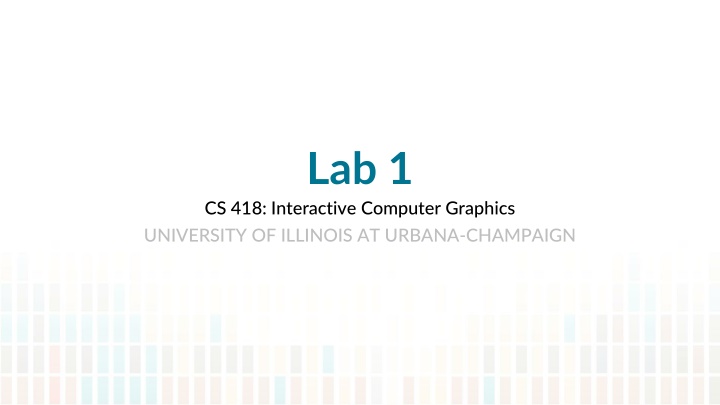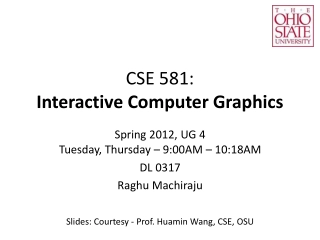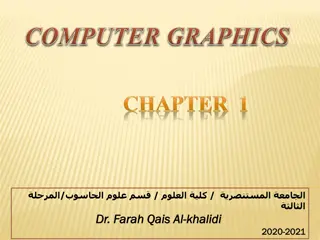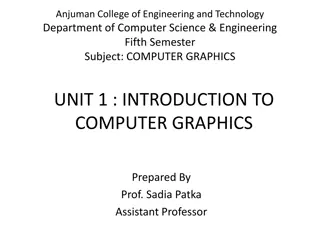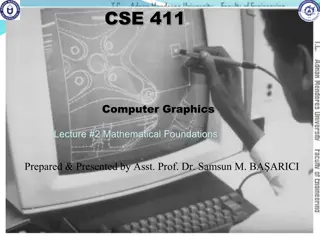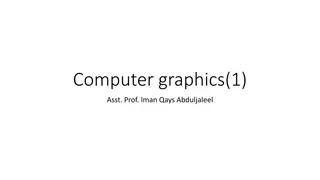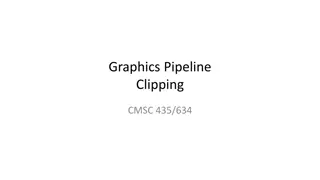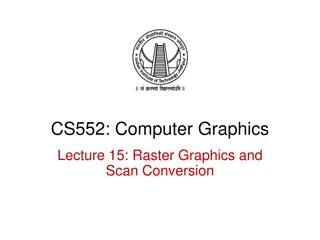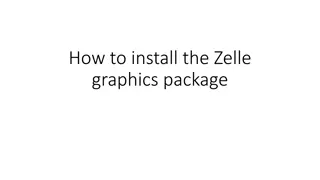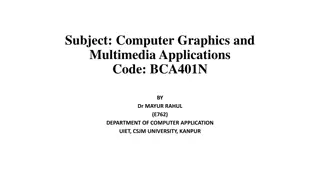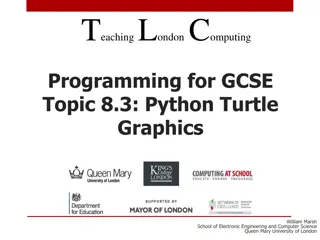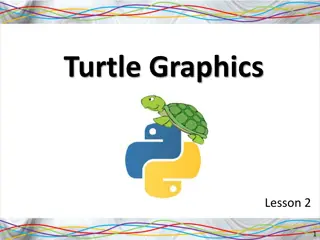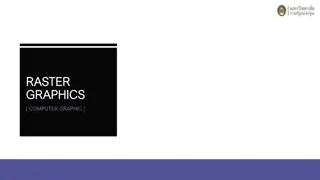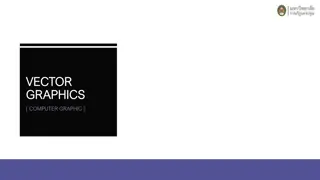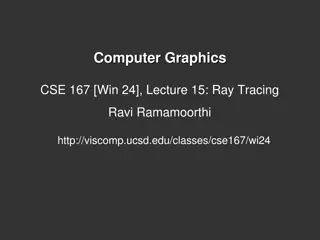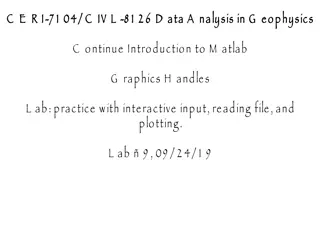Interactive Computer Graphics at University of Illinois
WebGL programming tips, view volume concepts, and useful resources for CS418 course. Learn about Chrome Dev Tools, coordinate systems, and the glmatrix library. Discover how to work with clip coordinates and transform geometry for rendering. Utilize recommended text editors and debugging environments for efficient development. Enhance your skills in WebGL programming with practical demos and machine problem specifications.
Download Presentation

Please find below an Image/Link to download the presentation.
The content on the website is provided AS IS for your information and personal use only. It may not be sold, licensed, or shared on other websites without obtaining consent from the author.If you encounter any issues during the download, it is possible that the publisher has removed the file from their server.
You are allowed to download the files provided on this website for personal or commercial use, subject to the condition that they are used lawfully. All files are the property of their respective owners.
The content on the website is provided AS IS for your information and personal use only. It may not be sold, licensed, or shared on other websites without obtaining consent from the author.
E N D
Presentation Transcript
Lab 1 CS 418: Interactive Computer Graphics UNIVERSITY OF ILLINOIS AT URBANA-CHAMPAIGN
Course Staff Apollo Ellis Ashwin Vijay Sid Oderberg
Agenda for today Some course information Intro to Chrome Dev Tools Machine Problem 1 specification Some WebGL programming tips The WebGL view volume The glmatrix library Uniform variables Programming demo
WebGL Resources Mozzilla WebGL API reference https://developer.mozilla.org/en-US/docs/Web/API/WebGL_API Tutorials Learning WebGL http://learningwebgl.com WebGL Fundamentals https://webglfundamentals.org/ Stack Overflow https://stackoverflow.com/
You Need a Text Editor Brackets is a good choice but whatever works for you is fine http://brackets.io/
Chrome Development Tools Recommended Development Environment http://www.google.com/chrome Built-in debugging environment within Google Chrome browser Use this to set breakpoints, examine variables, etc. Check out the chrome devtools overview https://developer.chrome.com/devtools I
WebGL View Volume View volume is a box running between [-1,1] in x, y, and z Geometry outside volume will not be rendered WebGL default eyepoint is on the z axis
WebGL View Volume How can you work with more convenient coordinates (e.g. [-100, 100])? Let s call those world coordinates . View volume coordinates are often called clip coordinates You can change coordinate systems pretty easily 1. Specify your geometry in whatever world coordinates you want 2. Transform the coordinates into clip coordinates 1. In other words scale down all your geometry to fit in the view volume 2. To do so we will use something called an affine transformation
Affine Transformations Quick Overview You can transform the coordinates of a vertex using a matrix Just multiply the matrix M times the vertex p Convention is to use right multiplication of vertex Mp=q You can easily perform Translation Scaling Rotation We will work with 4D vertex coordinates <x, y, z, w> where w=1 These are called homogeneous coordinates You will learn more in about them and transformations in lecture this week
Rotation You may also specify rotation about an arbitrary axis
The ortho Transformation The ortho transformation maps any rectangular axis-aligned viewing volume to the WebGL view volume It s basically just a translation and scale
Programming Transformations One way to move geometry is to apply an affine transformation to it. We can encode that transformation using a matrix multiplication The transformation can be implemented in the vertex shader In the JavaScript we create a matrix using the glMatrix library That matrix is then passed to the vertex shader as a Uniform variable Let s look at the code
The glmatrix Library A javascript library that supports 3D matrix and vector operations To use it grab a copy from glmatrix.net
The glmatrix Library Add a line to your html file with the location of the glmatrix library In this example, library is in the same folder/directory as html file Also, a set of utility JavaScript code is being used as well
Transforming a Vertex in a Shader This vertex shader code expects a matrix to be loaded from the application The matrix is provided as a uniform variable
Transforming a Vertex in a Shader In GLSL a uniform is a variable that is the same for all executions of a shader program in a given draw call In GLSL an attribute is a variable that may be different for all executions of a shader program in a given draw call
Creating an ortho Matrix in JavaScript First, when you create the shader program, get the uniform location shaderProgram.pMatrixUniform = gl.getUniformLocation(shaderProgram, "uPMatrix"); Create the matrix var pMatrix = mat4.create(); mat4.ortho(pMatrix, left, right , bottom , top , near, far); Send the matrix to the GPU before you issue a draw call gl.uniformMatrix4fv(shaderProgram.pMatrixUniform, false, pMatrix);
The ortho Matrix The parameters left and right are the x coordinates of the planes forming those sides of the view volume The parameters top and bottom are the y coordinates of the planes forming those sides of the view volume The parameters near and far are distances down the negative z axis measured from the origin For our 2D work we can just keep near=-1 and far=1
Programming Exercise 1. Download Brackets if you need an editor 2. Download the demo code and unzip it 3. Modify the code to display a capital block I instead of an L 4. Use a convenient coordinate system 5. Apply an ortho transformation to the block I 6. Test for correctness and debug 7. Make it multi-colored (e.g. display a gradient from orange to blue) 8. Test for correctness and debug Pro-tip: Implement and test each new feature separately
